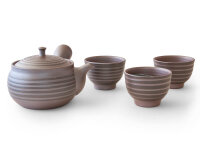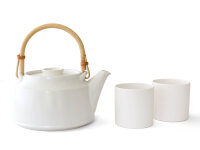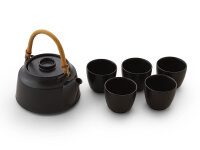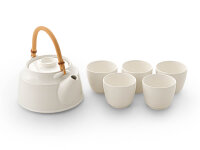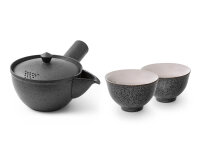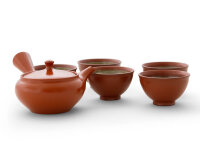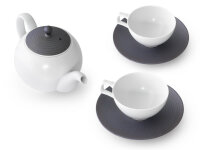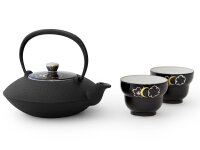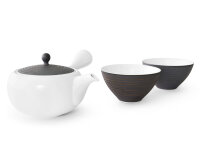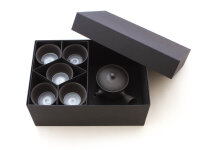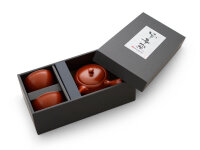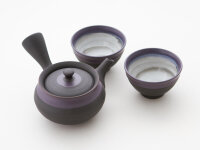Japanese tea service
A LITTLE PIECE OF TRADITION
The Japanese Tea Set - Tea Ceremony at Home
Tea is as much a part of Japan as the geisha and cherry blossoms. It's no wonder that tea ware also has a centuries-old tradition in Japan. From the tea ceremony to the small cup at home - here you can find the finest and most enduring ceramic and porcelain art for every variety. You can learn about the journey a tea set has gone through and how best to enjoy your tea with it.
Table of Contents
High-quality tea needs to be stored well
To preserve the aroma of tea for a long time, it is important to store it in a cool, dark place and in a closed container. Moisture and temperature fluctuations should be avoided as much as possible. The advantage of unflavored green tea is that, unlike flavored tea, it loses much less aroma, significantly extending the shelf life of green tea. What material should a tea canister ideally be made of? Plastic, which emits odors, can be very unhealthy and strongly alter the taste of green tea. In contrast, a tea canister made of metal is less of a concern. However, metal is a rather "cold" material, whether stainless steel or aluminum. Additionally, it is not capable of absorbing and regulating moisture. Therefore, we do not consider metal a good choice, especially when storing very high-quality tea. A natural, noble wood also fits much better with the ceremony of tea drinking.
Inspiration from China
The idea for Japanese teapots came from China: Yixing teapots had been made there for hundreds of years from red clay. The Tokoname region in the Aichi Prefecture of Japan is the oldest of the "six ancient kilns" in Japan, traditionally known for their high-quality ceramics. When potter Jin Shi Heng came from China to Tokoname in 1878, he taught his craftsmanship there and significantly contributed to the development of Japanese pottery from Tokoname. While a Chinese tea set is often made today with artificial clay materials and colors, in Japanese tea sets, only natural components are found.
"The New Objectivity" was an idea that served as the basis for the founders of the "Bauhaus". And the architects and designers who followed this idea - perhaps without primarily intending it - created a new emotional dimension. Purist design, minimalist design revealed a high and very intense emotional component, which was perceived as liberating and enriching. Less is indeed more when I can perceive and enjoy what is there more consciously and intensely. Less is indeed more when fewer products are created with more passion, enthusiasm, and craftsmanship. Less is indeed more when this less is more valued, receives better care and attention, and accompanies us longer.
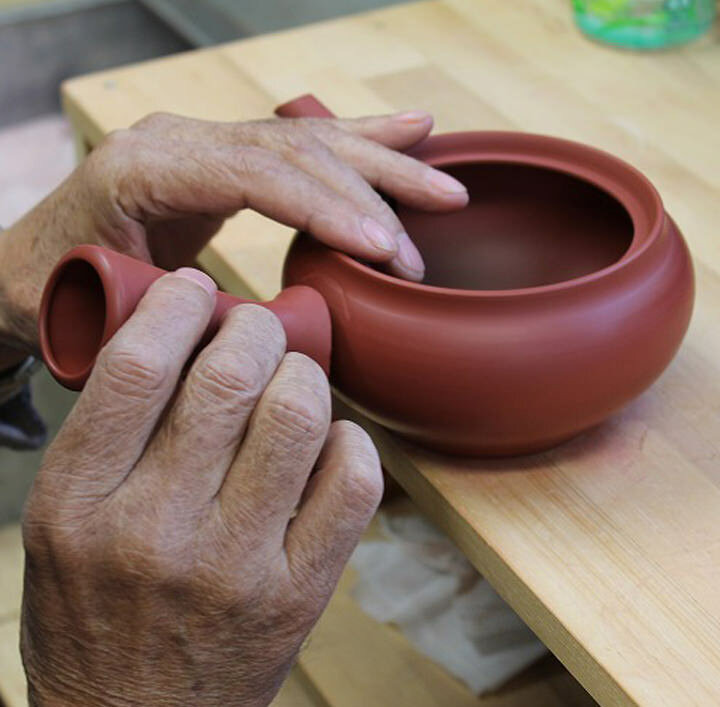
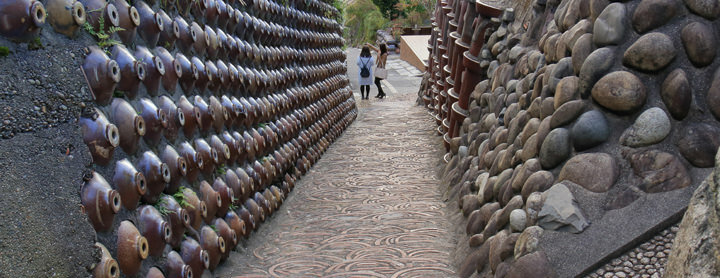
In Tokoname, ceramics have been produced since the 12th century. There are special clay deposits with high iron oxide content from rice fields, which make the ceramics from the region unique. Since the spread of the tea ceremony, tea pots and matcha bowls (Chawan) made of red clay have been particularly popular. These correspond to the Wabi-Sabi principle of the tea ceremony: the return to natural, enduring simplicity is among the qualities that make the beauty of this art. Generations of tea masters and geishas have learned to handle a Japanese tea set in this way.
Japanese Tea Sets - Devotion for the Best Tea Experience
During the early days, the ash glazing technique was particularly widespread, which is still often used today. The old Tokoname ceramics, originally light brown with a slightly green ash glaze on the edges, are still valued today for their simplicity and robustness. Once a product for the lower aristocracy who could not afford Chinese porcelain, they are now a cherished piece of Japanese culture. After mass production during industrialization and the influence of Western aesthetics, there is now a trend back to traditional pottery styles and firing techniques.
At the beginning of production, the clay is dried in large slabs for months and then crushed by special machines and mills. Valuable minerals and other components are also added, and depending on the need, different types of clay can be mixed, making the resulting tea set unique. The minerals and iron in the clay not only give it the characteristic red color but also make it particularly stable and high-quality. Even the taste of the tea is enhanced: the minerals bind bitter substances in the tea, making it smoother and more aromatic.
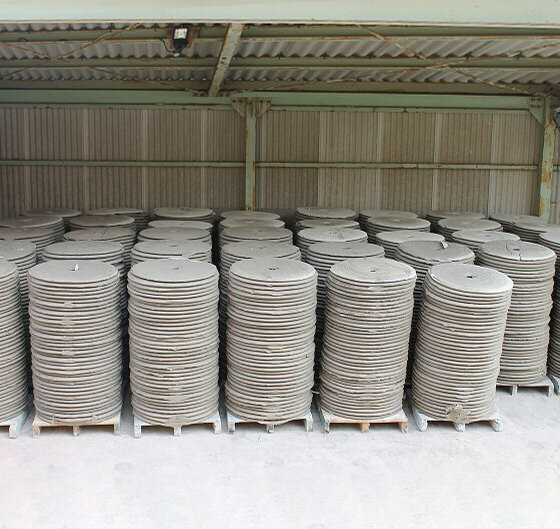
Tableware or Artwork?
Another peculiarity: the clay can not only be cast in shape but also turned on special potter's wheels, which requires a lot of skill and experience. A craftsman who has proven himself in the art of pottery for over 12 years and particularly excels in traditional techniques has the chance to be appointed as a Dento Kogeshi (Master of Traditional Crafts) by the Japanese Ministry of International Trade and Industry. Today, there are approximately over 30 ceramic masters in Japan. Craftsmanship and art go hand in hand in Japan, both bearing the name Geijutsu.
The lid, handle, and spout of the Japanese teapot are made separately and then assembled. On many pots, you can still see the traces of the tools used to attach them - a part of the Wabi-Sabi aesthetic that values authenticity. The bottom of the teapot also receives an individual engraving from the craftsman. During the subsequent glazing process, the artist can infuse a lot of individuality into the design, for example, by creating unique patterns on the tea ware using algae (Mogake technique). Once finished, the teapots, after being dried for at least a week, undergo the final step on a shelf in the kiln. There, they are usually fired for 15 hours. Traditionally, wood or charcoal kilns were used, but today, efficient electric kilns are preferred. Depending on the firing technique, the color of the ceramic ware can also be altered.

Tea Set Made of Ceramic and Porcelain
What's the difference? While ceramic is made from fired clay, porcelain is made from ground stones. Porcelain also requires a much higher firing temperature, 1300 degrees, compared to 1150 degrees for ceramic. The fine porcelain tea sets in Japan are often richly decorated with traditional patterns and scenes. For example, the face of a geisha on it can remind one that the tea ceremony has been part of the basic training for this profession since the 17th century.
Whether a ceramic tea set is glazed on the outside or not is a matter of taste. However, it plays a significant role in the taste of the tea inside: unglazed tea pots absorb the aroma of the tea much better with their porous clay. Only one type of tea should be prepared in these to avoid altering the taste, while many different varieties are possible in glazed tea pots. Japanese porcelain tea pots are equally versatile but do not optimize the flavor as well.
Teapots in Japan are often made with a built-in strainer. The purpose is to give the tea more room to steep. Additionally, the filter must be very fine to effectively trap the small tea leaves. Among different types of filters, whether made of stainless steel or clay, ceramic filters traditionally attached to the spout or lid are common. These are either cut directly from the body of the pot or separately made, as is the case with the spherical sieves. At Oryoki, you will find handcrafted Kyusu made of both porcelain and ceramic. The sometimes very different prices of a Japanese Kyusu are based, incidentally, on the effort involved in manufacturing in the factory or by the master. Some of the Kyusu are produced in very limited quantities by specialized masters with decades of experience, creating popular rarities of a sadly dying craft.
Which tea service is right for you?
What makes a Japanese tea set special is not only its high quality and aesthetics. The teapots for Japanese green tea, called Kyusu, are also constructed differently. With the brewing technique for tea, which was established in Japan only in the 17th century, the first Kyusu was created – before that, tea in powder form was processed directly in the bowl. There are Japanese teapots and tea sets in various sizes and shapes, and especially the handles play a role. They can be at the top, like the bamboo handle of the Uwade, or at the back like the Ushirode, which is particularly popular for Chinese or English tea. Houjicha is preferably brewed in an Uwade. However, the handle can also be completely absent, as with the one-handed Shiboridashi pot. The latter is best used for green tea that is not so hot that you couldn't touch the pot. The tall variant is called Hohin and is optimal for brewing Gyokuro.
The most famous Japanese Kyusu has a side handle, which makes pouring the tea very easy – the Yokode Kyusu. This relatively small clay pot often holds around 270 ml and is particularly suitable for brewing Sencha. The size of the teapot plays an important role in tea preparation: the best Houjicha is obtained from a large pot, while smaller pots are preferred for Gyokuro. Contrary to the western habit of filling cups to the brim, tea cups are always filled only partially.
A Japanese teapot is easy to maintain: water is all it needs for cleaning – soap can affect the taste of the tea. Simply let excess water evaporate and you will have a Kyusu for a lifetime. Enjoy your Japanese green tea from a unique Japanese tea set from Tokoname.




